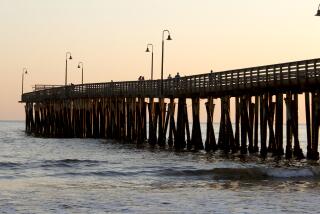Battle Waged Over Project in Pier Area : Development: Huntington Beach city officials and environmentalists take opposing views of the planned Pierside Village on the ocean side of Pacific Coast Highway.
- Share via
HUNTINGTON BEACH — On the gentle rise of clay bluffs where sand and sea meet, Gabrieleno Indians once foraged for food and provisions. Sir Francis Drake sailed by in 1579, and in 1904, it was here that Henry Huntington’s fabled red electric trains whisked in amid great fanfare.
And now this core area of Huntington Beach, the beach-bluff land adjacent to the pier, waits its next turn with history. Environmentalists and city officials are in a virtual civil war over whether to build on the land--the proposed project is called Pierside Village--or to leave it in its semi-developed, paved parking lot condition.
A court case involving the land was settled without trial last week, but the legal settlement failed to resolve the central dispute: whether the land should be left essentially undeveloped or whether it should be built into a plaza of fountains, walkways and restaurants in the Pierside Village project.
Pierside Village provokes strong passions in this community. It has divided the City Council and galvanized environmental groups that loathe the idea of building on land next to the public beach. It has also served as a rallying point for pro-development civic groups that have long decried the tattered look of downtown and the main beach.
“The new project will be a great asset to our city,” said Tom Van Tuyl, president of the Huntington Beach-Fountain Valley Board of Realtors. Pierside Village, he said, would “transform a parking lot which has no public facilities at this time into more than 2.5 acres of public plazas and promenades, which will be open to public use.”
But Geri Ortega, chairwoman of the city Planning Commission, strenuously disagreed.
“The project has been deficient from the first time out of the gate,” she said. Ortega and other critics contend that building commercial restaurants on the ocean side of Pacific Coast Highway would defile the beach.
Project critics had hoped that a lawsuit would cripple or destroy Pierside Village. The lawsuit was filed in 1986 as the city tried, through eminent domain action, to gain title to the three acres of land proposed for the project. During the four-year wait for a court hearing, the state attorney general’s office and the State Lands Commission sought to block the project, claiming that new restaurants would violate a public easement on the land and would also block public access to the beach.
The suit was settled, without trial, last week in Orange County Superior Court with both the city and state claiming victory. The city said it had won clear legal title to the three acres of land because of the suit. The state claimed it had succeeded in keeping intact the public easement on the land and disagreed that the city had won clear title to the land.
Whatever the legal points, Pierside Village did not get the death blow most of its critics had wanted.
The acreage proposed for Pierside Village is not pristine beach. The narrow strip of land currently is occupied by Maxwell’s Restaurant and a string of paved parking lots that extend from Main Street to 1st (formerly Lake) Street.
Plans call for remodeling and moving Maxwell’s Restaurant and building two new restaurants. The three buildings would be on a landscaped plaza, with three levels of parking underneath the plaza. The existing paved parking lots on the land currently provide 220 parking slots. Pierside Village’s underground garage would have 510 spaces.
Councilman John Erskine, a strong supporter of the concept, believes the existing situation on the beach-bluff land is not only ugly but unsafe.
“Right now it’s a blighted parking lot and a hangout for dope smokers and ne’er-do-wells,” Erskine said. “It’s certainly not scenic in its present condition, and people don’t go there to view the ocean. But they would be able to go there and get a good view of the ocean if Pierside Village is built. It would be a place for older adults to enjoy. They could sit on the benches and enjoy the view.”
Jonathan Chodos, spokesman for Pierside Development, which hopes to build the restaurant project, thinks some critics have used the “public access” issue as a sham argument against the project. “I’ve always thought talk about public access was a red herring,” Chodos said. “People would have easier access to view the ocean if this project is built.”
But Deputy Atty. Gen. Robert G. Collins says the state does not believe commercial restaurants should be on land dedicated as a public easement.
“That easement still stands, and I don’t think big restaurants are compatible with the easement, “ Collins said. He added that he doubts the California Coastal Commission will approve construction permits for Pierside Village.
Debbie Cook, spokeswoman for Save Our Parks, added that her group would “go back to court if necessary on this. Pierside Village is not what is meant by ‘public recreational use’ of this land and that’s what the easement protects.”
Erskine countered that Cook and other outspoken critics “are just using this out of political motivation. . . . Most of the other people I talk to in this city don’t have anything bad to say about Pierside Village.”
But Councilwoman Grace Winchell, one of the two council members opposed to the project, recently said that very serious environmental concerns are at stake. Winchell, speaking at a council meeting, said many people were opposed to Pierside Village because it would put more commercial development on the ocean side of Pacific Coast Highway.
“This beach is our crown. . . . Let’s not destroy the crown,” she said.
More to Read
Sign up for Essential California
The most important California stories and recommendations in your inbox every morning.
You may occasionally receive promotional content from the Los Angeles Times.










